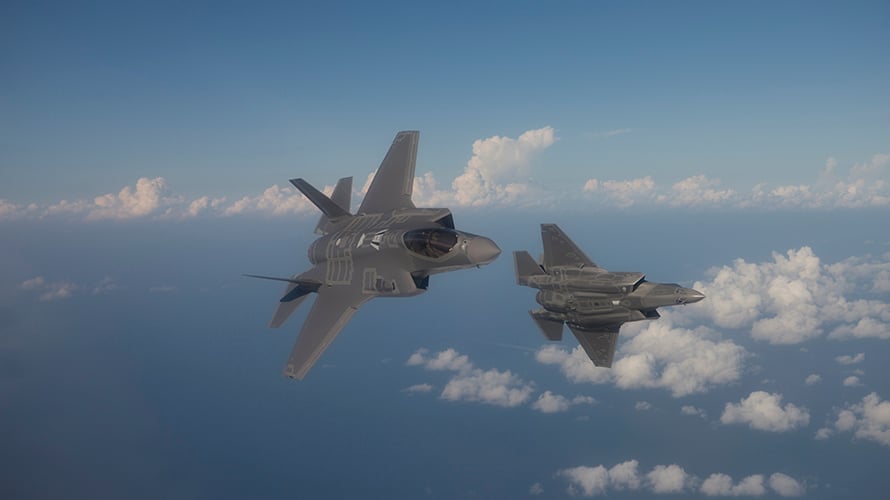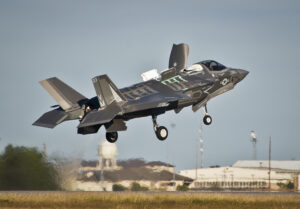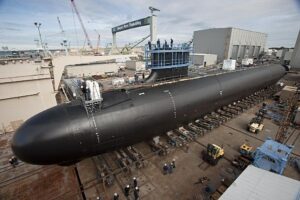
F-35 fighters
UPDATED from HASC briefing WASHINGTON: The House and Senate Armed Services Committees are an impressive $2 billion apart on the F-35, with the HASC hoping to cut upgrades, depots and other support for the controversial Joint Strike Fighter while the SASC seeks to buy more jets.
UPDATE “The F-35 program is troubled enough as it is,” a House Armed Services Committee aide told reporters this afternoon. It’s premature to pile on more funding for more aircraft, they said, “until the vendor demonstrates they are able to produce F-35s on time.”
HASC funding tables obtained by Breaking Defense, when compared to the numbers SASC published Tuesday night, show the Democrat-controlled House committee and the Republican-controlled Senate panel agree more than they disagree on the vast array of weapons spending, but those disagreements still add up to billions. Some key examples:
- Both bodies restore a Virginia-class attack submarine the Trump Administration would have cut, but the HASC cuts other shipbuilding programs to build the sub sooner; HASC adds $2.16 billion to shipbuilding overall when SASC added $1.35 billion. UPDATE A HASC aide argued vehemently that SASC really only funds a quarter of the missing sub, punting most of the cost to another year — which could disrupt the production line not only for Virginias but for the larger Columbia class. (Much more on this below).
- Both are skeptical of the Navy’s rush to build prototypes of unmanned warships and submarines without testing key technologies first, but the Senate cuts the prototypes more steeply, by over $548 million versus HASC’s $343.8 million. (Note these are rough figures since these programs are widely scattered across the budget, so we may well have missed one).
- Both add the eighth THAAD battery requested by the Missile Defense Agency, but the SASC’s $394.4 will build the unit faster than HASC’s $106 million.
- Both support the push for multiple types of hypersonic missiles, although the SASC dings several hypersonics programs with $102 million in cuts, a difference of a few percent, to express displeasure with how they’re being managed.

F-35B in hover mode
Fighting Over Fighters
This longstanding tradition of bipartisan and bicameral consensus on defense makes it all the more remarkable when the House and Senate committees disagree as sharply as they do on F-35. The Joint Strike Fighter has largely overcome its decades of schedule delays and cost overruns to become the mainstay of US airpower modernization. But considerable controversy still dogs the program.
So while SASC adds $1.36 billion to buy more Air Force F-35As, Marine F-35Bs, and Navy F-35Cs, plus spare parts, HASC keeps the total number of aircraft being bought the same and then docks at least a score of supporting line items by a total of $561 million. These cuts include:
- $150 million from the Air Force for “excess miscellaneous support costs”;
- $134.6 million (divided among the three variants) for anticipated savings from the upcoming Lot 15 contract;
- $92 million (over four line items) for various delays in the plane’s Block IV software upgrade;
- $38.6 million (over four line items) for various aspects of ALIS, the F-35’s notoriously buggy maintenance software;
- $33.5 million (divided among the three variants) for “excess” costs to stand up more maintenance depots.
Now, HASC isn’t cutting the same line items that the SASC is increasing. But it’s hard to increase the number of aircraft you’re buying, as SASC wants, at the same time you’re cutting the support infrastructure for those aircraft, as HASC wants.
If history is any guide, Senate Armed Services will likely win in the end. It has a powerful ally in the House: the House Appropriations Committee, whose senior Republican, Rep. Kay Granger, represents the Fort Worth district where the F-35 is built. Whatever the two Armed Services committees decide, the final funding figure is actually up to the appropriators.

The Virginia-class attack submarine USS Minnesota under construction in Newport News.
Differences Over The Fleet
While the House and Senate Armed Services committees both sought to restore the. Virginia submarine cut by Trump’s budget and cut unmanned warship prototypes, they did so in markedly different ways.
All told, the administration asked for just over $19.9 billion for the Shipbuilding & Conversion, Navy (SCN) account. Both committees increased that, but by different amounts: SASC by $1.35 billion (7%); HASC by $2.16 billion (11%).
That’s in large part because, while SASC restored the submarine by adding $472 million in Advanced Procurement to start buying it, with funding to finish it left to a later year, the HASC restored the full $2.6 billion to buy it in 2021.
UPDATE Congress, shipyards, and the Navy have labored mightily to keep building two Virginias a year, but after the Trump administration cut one from its 2021 request, “the Senate did nothing to fund the second submarine in FY 21,” a HASC staffer told reporters.
The $472 million SASC labeled Advanced Procurement is only enough to buy the submarine’s reactor, the staffer elaborated to me after the conference call. You’d need to find nearly $3 billion more to buy the whole boat, he said, and you’d need to find that money in the next two years. Otherwise, not only are you stuck with a useless fraction of a Virginia submarine, you disrupt the production line so badly it hurts the larger Columbia class as well.
Without full funding for two Virginias in 2021, the shipyards, Electric Boat and Newport News, will have to start laying off workers — at the very time they need to ramp up their workforce to build the even larger Columbia class. The shipyards’ contract with the Navy and the multi-year timeline to buy a sub give them some leeway to keep building two boats a year, the staffer said, but by 2023 they’d run out of room and have to start layoffs.UPDATE ENDS
To make up the full amount required to restore the Virginia submarine, HASC also had to dock several other shipbuilding programs that SASC increased.
The major differences, besides the Virginia?
- Columbia-class nuclear missile submarine: SASC added $175 million to shore up the shaky submarine supplier base; HASC added nothing UPDATE but would argue their plus-up to the Virginia program does much more to keep the supplier base strong.
- Ford-class aircraft carrier: SASC funded the administration’s full request; HASC cut $90 million.
- Arleigh Burke destroyers: SASC cut $30 million, HASC funded the full request.
- Amphibious ships: SASC added $500 million to both the mid-size LPD class and the larger LHA, HASC cut $37.7 million from LPD and did nothing on LHA.
- Support craft: SASC cut $126 million from various landing craft and other auxiliaries, HASC funded the full request.
Given the popularity of shipbuilding programs, which are big employers in many states, the odds are good that the final compromise will have more adds than cuts.
Both bills also include hundreds of pages of other policy changes and pronouncements. We’ll delve more into those tomorrow, but there’s one intriguing item we’ve couldn’t wait to share. The HASC wants to create a deputy assistant secretary for sustainment in each of the three service departments (the Navy Dept. includes the Marine Corps), which would boost oversight of the maintenance, overhaul and upgrade costs that far outweigh the up-front cost to purchase new equipment. The SASC’s bill makes no mention of the idea so senators are likely to have some pointed feedback, especially in this era when HQ bloat is such a popular topic.
Northrop sees F-16 IVEWS, IBCS as ‘multibillion dollar’ international sales drivers
In addition, CEO Kathy Warden says the company sees a chance to sell up to five Triton UAVs to the NATO alliance.


























